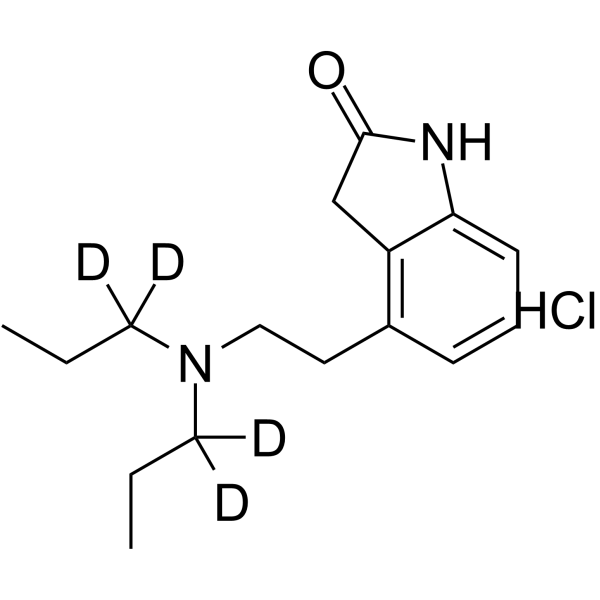Ropinirole-d4 hydrochloride
Modify Date: 2024-01-08 15:22:12

Ropinirole-d4 hydrochloride structure
|
Common Name | Ropinirole-d4 hydrochloride | ||
|---|---|---|---|---|
| CAS Number | 1330261-37-4 | Molecular Weight | 300.86 | |
| Density | N/A | Boiling Point | N/A | |
| Molecular Formula | C16H21D4ClN2O | Melting Point | N/A | |
| MSDS | N/A | Flash Point | N/A | |
Use of Ropinirole-d4 hydrochlorideRopinirole-d4 (SKF 101468-d4) hydrochloride is the deuterium labeled Ropinirole hydrochloride. Ropinirole hydrochloride is a potent D3/D2 receptor agonist with a Ki of 29 nM for D2 receptor. Ropinirole hydrochloride has pEC50s of 7.4, 8.4 and 6.8 for hD2, hD3 and hD4 receptors, respectively. Ropinirole hydrochloride has no affinity for the D1 receptors. Ropinirole hydrochloride has the potential for Parkinson's disease[1][2]. |
| Name | Ropinirole-d4 hydrochloride |
|---|
| Description | Ropinirole-d4 (SKF 101468-d4) hydrochloride is the deuterium labeled Ropinirole hydrochloride. Ropinirole hydrochloride is a potent D3/D2 receptor agonist with a Ki of 29 nM for D2 receptor. Ropinirole hydrochloride has pEC50s of 7.4, 8.4 and 6.8 for hD2, hD3 and hD4 receptors, respectively. Ropinirole hydrochloride has no affinity for the D1 receptors. Ropinirole hydrochloride has the potential for Parkinson's disease[1][2]. |
|---|---|
| Related Catalog | |
| In Vitro | Stable heavy isotopes of hydrogen, carbon, and other elements have been incorporated into drug molecules, largely as tracers for quantitation during the drug development process. Deuteration has gained attention because of its potential to affect the pharmacokinetic and metabolic profiles of drugs[1]. |
| References |
| Molecular Formula | C16H21D4ClN2O |
|---|---|
| Molecular Weight | 300.86 |